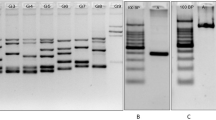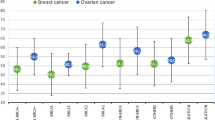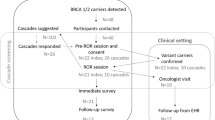Abstract
Two recent papers suggest distorted sex and transmission ratios associated with BRCA1 mutations. If real, these would provide novel insights into the normal biological function of this gene and have implications for genetic epidemiologic methods used to estimate penetrance. We addressed these observations in two settings: offspring of 283 mutation carriers and 471 mutation negative subjects from BRCA1/2 mutation-positive families with multiple cases of breast and ovarian cancer (NCI families); and relatives of 115 BRCA1/2 mutation carriers from the Washington Ashkenazi Study (WAS). The male:female ratio was below one in both BRCA1 (0.85, 95% CI 0.7–1.1 in NCI families; 0.90, 95% CI 0.6–1.4 in WAS) and BRCA2 families (0.77, 95% CI 0.5–1.3 and 0.80, 95% CI 0.5–1.2, in the NCI and WAS study groups, respectively). None of the sex ratios deviated significantly from one, and there was no significant difference between BRCA1 and BRCA2 families. The reduced sex ratio was due largely to the offspring of males, a distortion that is probably an artifact of ascertainment biases. Among adult daughters without breast or ovarian cancer born to mutation carriers, as expected, fewer than 50% were mutation carriers (39% in BRCA1 families and 44% in BRCA2 families). It is difficult, due to ascertainment biases, to draw firm conclusions regarding sex ratios in studies of a sex-limited phenotype. Nonetheless, these observations do not support the idea that BRCA1 mutation carriers have a lower ratio of male offspring than BRCA2 mutation carriers.
Similar content being viewed by others
Log in or create a free account to read this content
Gain free access to this article, as well as selected content from this journal and more on nature.com
or
References
de la Hoya M, Fernandez JM, Tosar A et al: Association between BRCA1 mutations and ratio of female to male births in offspring of families with breast cancer, ovarian cancer, or both. JAMA 2003; 290: 929–931.
Gronwald J, Gorski B, Byrski T et al: Non-random transmission of mutant alleles to female offspring of BRCA1 carriers in Poland. J Med Genet 2003; 40: 719–720.
Wacholder S, Hartge P, Struewing JP et al: The kin-cohort study for estimating penetrance. Am J Epidemiol 1998; 148: 623–630.
Struewing JP, Brody LC, Erdos MR et al: Detection of eight BRCA1 mutations in 10 breast/ovarian cancer families, including 1 family with male breast cancer. Am J Hum Genet 1995; 57: 1–7.
Struewing JP, Hartge P, Wacholder S et al: The risk of cancer associated with specific mutations of BRCA1 and BRCA2 among Ashkenazi Jews. N Engl J Med 1997; 336: 1401–1408.
Schlesselman JJ : Case–Control Studies. New York, NY: Oxford University Press; 1982.
Biesecker BB, Ishibe N, Hadley DW et al: Psychosocial factors predicting BRCA1/BRCA2 testing decisions in members of hereditary breast and ovarian cancer families. Am J Med Genet 2000; 93: 257–263.
Author information
Authors and Affiliations
Corresponding author
Rights and permissions
About this article
Cite this article
Struewing, J., Hartge, P., Wacholder, S. et al. BRCA1 and sex ratio. Eur J Hum Genet 12, 663–667 (2004). https://doi.org/10.1038/sj.ejhg.5201210
Received:
Revised:
Accepted:
Published:
Issue date:
DOI: https://doi.org/10.1038/sj.ejhg.5201210
Keywords
This article is cited by
-
No association between BRCA mutations and sex ratio in offspring of Pakistani BRCA mutation carriers
Breast Cancer Research and Treatment (2007)
-
Sex Ratio Distortion in Offspring of Families with BRCA1 or BRCA2 Mutant Alleles: An Ascertainment Bias Phenomenon?
Breast Cancer Research and Treatment (2005)
-
Ratio of male to female births in the offspring of BRCA1 and BRCA2 carriers
Familial Cancer (2005)



